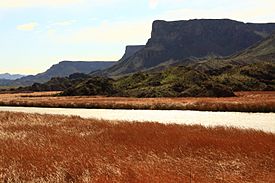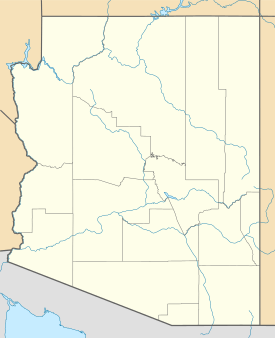Bill Williams River facts for kids
Quick facts for kids Bill Williams River |
|
|---|---|

Near mouth at Lake Havasu
|
|
|
Location of the mouth of the Bill Williams River in Arizona
|
|
| Country | United States |
| State | Arizona |
| County | Mohave, La Paz |
| Physical characteristics | |
| Main source | confluence of the Big Sandy and Santa Maria rivers Alamo Lake 1,175 ft (358 m) 34°18′38″N 113°31′36″W / 34.31056°N 113.52667°W |
| River mouth | Colorado River Lake Havasu 453 ft (138 m) 34°18′16″N 114°08′07″W / 34.30444°N 114.13528°W |
| Length | 46.3 mi (74.5 km) |
| Basin features | |
| Basin size | 5,373 sq mi (13,920 km2) |
The Bill Williams River is a river in west-central Arizona, about 46 miles (74 km) long. It flows west and empties into the mighty Colorado River. This river, along with its helper, the Santa Maria River, forms a natural border. It separates Mohave County to the north from La Paz County to the south.
The Bill Williams River is a major waterway that drains into the Colorado River. This happens south of the famous Hoover Dam and Lake Mead. The area of land where all the water drains into the river, called its drainage basin, covers parts of northwest and west-central Arizona. The Bill Williams River meets the Colorado River between the towns of Parker and Lake Havasu City.
Around the river, you can find several mountain ranges. To the north are the Artillery Mountains, the Rawhide Mountains, and the Bill Williams Mountains. To the south are the Buckskin Mountains. An old mining town, Swansea, which is now a ghost town, is located about 3.7 miles (6 km) south of the river in the Buckskin Mountains.
Where Does the River Start?
The Bill Williams River is formed when two other rivers join together. These are the Big Sandy River and the Santa Maria River. Just west of where these two rivers meet, you'll find Alamo Lake. This lake is a special reservoir built to help control floods.
Alamo Lake and its state park are very popular for fishing and other fun outdoor activities. The Bill Williams River flows until it meets the Colorado River just north of Parker Dam. The entire area around the river is protected. It includes state parks like Buckskin Mountain State Park and Cattail Cove State Park. There are also wilderness areas such as Gibraltar Mountain, Swansea, and Cactus Plain wilderness areas. These places help protect the natural environment.
What Animals and Plants Live Here?
The Bill Williams River is home to many different kinds of fish. You might find largemouth bass, yellow bullhead, green sunfish, and bluegill. Other fish include carp, mosquitofish, and red shiner. There's also a special fish called the razorback sucker.
Many other animals live in or near the water. These include the lowland leopard frog, North American river otter, and beaver. You might also see muskrat, the Arizona toad, and spiny-spotted turtles.
Along the riverbanks, where the land meets the water, you'll find many plants. These include different kinds of willow trees. There are also bulrushes and saltcedar plants. The Bill Williams Wildlife Refuge, located near Parker, is a very important place for birds. Over 335 different kinds of birds visit this refuge!
Protecting the River and Its Wildlife
The Bill Williams River National Wildlife Refuge is a special place that protects the lower part of the river. It stretches all the way to where the river flows into Lake Havasu. This refuge is part of the Sonoran Desert and has a rare type of riverbank habitat.
This unique habitat attracts many Neotropical migratory birds. These birds travel all the way from Central and South America. They stop at the refuge on their long journey to their breeding grounds further north. The refuge is also home to one of the last natural forests of cottonwood and willow trees along the lower Colorado River. The main trees you'll see here are Fremont's cottonwood and Goodding's willow.


